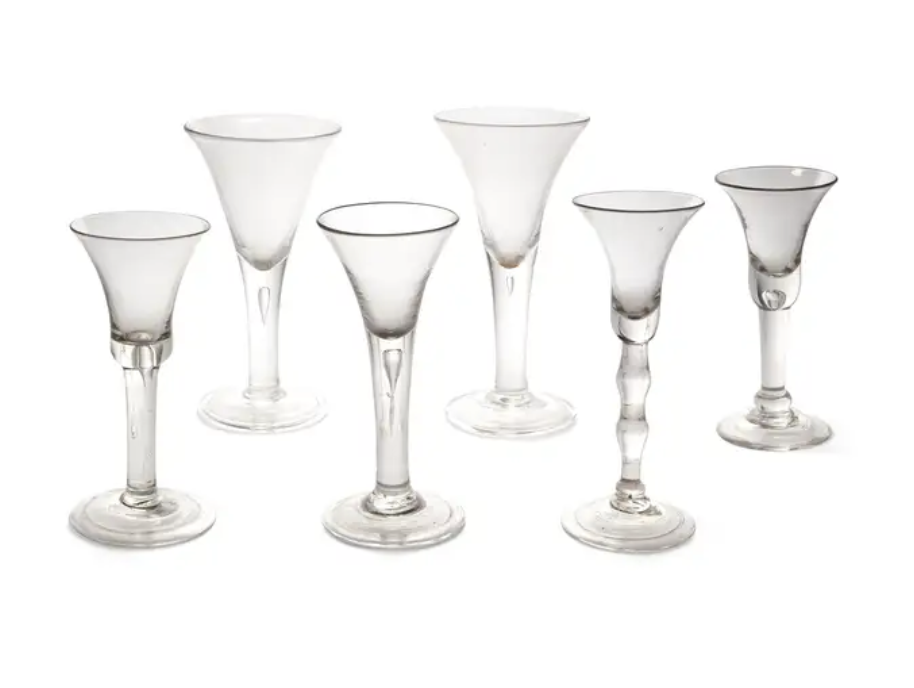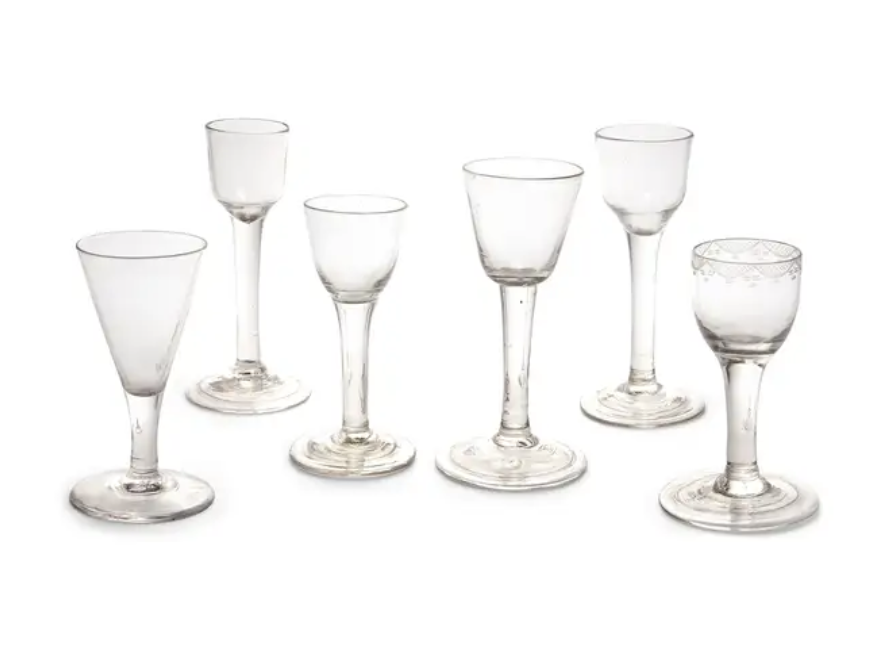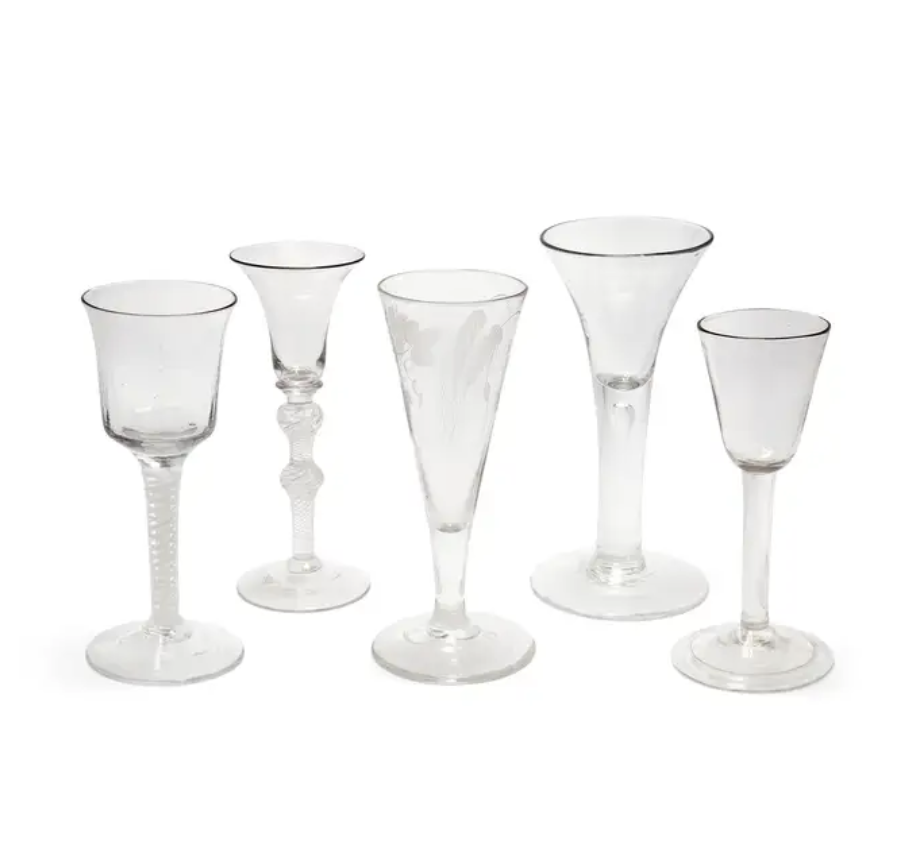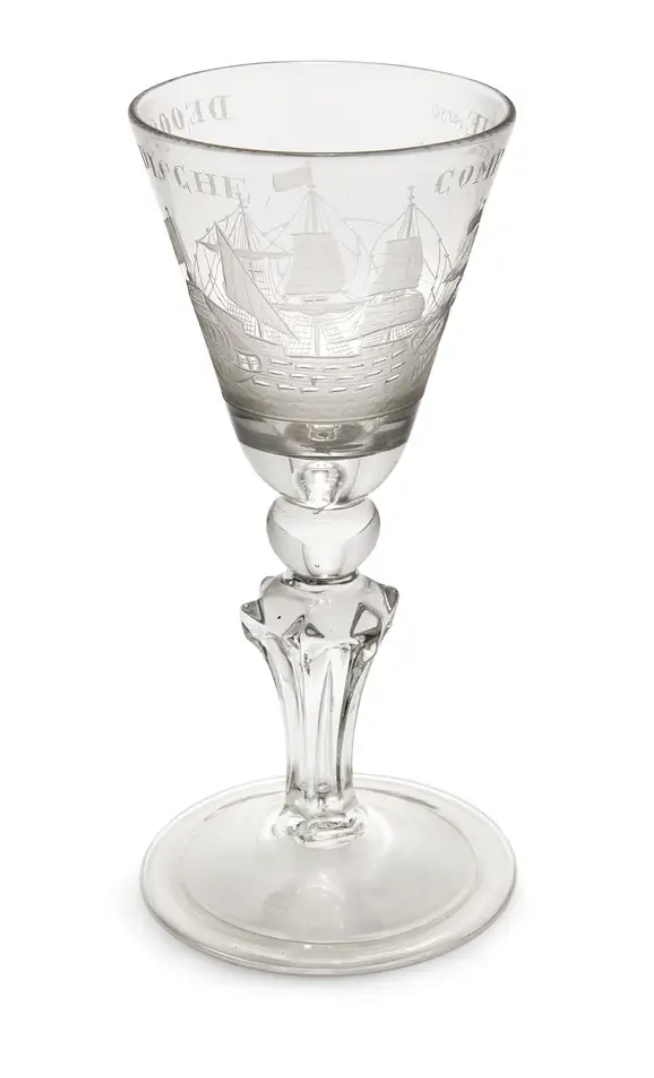Ever since George Ravenscroft, a persevering analytical chemist from Henley-on-Thames, first produced clear lead crystal glassware on an industrial scale, glassmakers of the 18th century sought to produce drinking glasses of increasingly great variety and complexity to satisfy the drinking-heavy populace of 18th century society. Today, glasses of the 18th century are the most widely collected due to their abundance, quality, and many variations of shape, size, and decoration.
So, say you just inherited some drinking glasses, or you are interested in starting your own collection – what should you be looking for in an 18th century drinking glass? Let’s start at the bottom and work our way up.
The first familiar feature to look for on early drinking vessels is the pontil mark, found at the centre of the base of a glass: a rough edge caused by the breaking of the finished glass from the pontil (a rod of iron) with a sharp tap. After the middle of the 18th century the method of grinding the base to a smooth finish came into fashion, and by 1780 it was common practice, therefore glasses of this time and later rarely have a pontil mark.
Lot 342: A group of six Georgian wine glasses with
plain teardrop stems, mid-18th century
Another tell for the earliest clear lead drinking glasses from 1685 onwards is the presence of a ‘folded foot’, where the base of the glass is strengthened against chipping and other damages from everyday use by having a double layer of glass around the rim. Following the Glass Excise Act of 1745, a tax imposed on glassmaking materials by Parliament to fund war efforts, the presence of the folded foot becomes more unusual as glassmakers sought to cut costs.
Other types of foot to look out for include domed feet, corrugated or terraced feet associated primarily with sturdy ‘firing’ glasses, designed to withstand the impact of being banged onto a table after a toast, and rib-moulded feet found more commonly on sweetmeat or champagne glasses due to their delicacy and unsuitability for drinking purposes.
The stem is one of the most useful parts of the glass to define its age, as unlike bowls and feet, stem types can be sorted into period groupings. We have Edward Arnold to thank for these groups, first described in his seminal 1897 publication Old English Glasses.
The groups, in summary, are as follows:
- The 1st period, from c.1685-1735, saw the introduction of heavy, thickly blown baluster stems. We also find lighter baluster stems from c.1725 onward, and moulded pedestal stems from c.1715 onward, also called ‘Silesian’ stems, not because of any direct link to Silesia but instead in reference to the Hanoverian George I ascending the British throne in 1714.
- The 2nd period, c.1730-40, is where we first see plain stems, sometimes tapering to the bowl, a style that would remain in fashion for the rest of the 18th century due to its simplicity.
- The 3rd period, c.1740-55, is characterised by air twist stems, which includes the rarer combinations of air and colour twists.
- The 4th period, c.1755-80, is defined by the opaque twist and enamel twist, and various combinations of each.
- Finally, the 5th period of c.1770-1800 is where we find faceted or cut stems.
Lot 341: A group of six Georgian cordial glasses
with plain stems, mid-18th century
Naturally these groupings are approximate and not exhaustive, they are useful as indications of when certain stem types were at their most popular and fashionable.
The bowl of an 18th century drinking glass can vary enormously in shape and size but will nearly always be smaller than modern alternatives. The names of bowl shapes include funnel, bell, bucket, ogee, double ogee, ovoid, trumpet, cup, thistle, fluted, hexagonal, ribbed, barrel, and many more! Apart from the earliest examples up to 1700 which usually have funnel bowls, all kinds of bowl shapes can be found on glasses across the 18th century, making them less useful for dating but more useful for working out the function of a glass, and who may have owned it.
Lot 425: A group of Georgian wine and ale glasses, 18th century
While most drinking glasses can be denoted as “wine” glasses, certain distinct types connected with other types of drink are worth noting, such as ale glasses with their longer, graceful tapering bowls engraved with motifs of hops and barley, or cordial glasses, with their smaller bowls usually of funnel or ogee shape, and exceptionally long stems to compensate for their height.
Lot 424: A Dutch-engraved Silesian-stemmed shipping goblet, c.1740
The presence of engraved decoration on bowls can be most useful for discovering who may have owned it, or for what reason the glass was made. Armorial crests, historical events, racing motifs, nautical subjects, military conquests, and political symbolism can all be found in the decorations on drinking glasses. Sometimes a wine glass can be engraved with simply grapes and vines, while the presence of a thistle can indicate Jacobite support against the crown, or a ship with the letters VOC for the powerful Dutch East India Company.
This guide will provide you with a few important details with which to begin identifying 18th century drinking glasses. As with all antiques, the best way to learn is by viewing and handling glasses yourself, and Roseberys’ upcoming Fine & Decorative auction on 20th March has several lots of 18th century glassware for you to explore.








